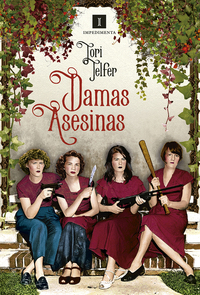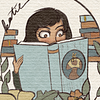Take a photo of a barcode or cover
dark
emotional
informative
sad
medium-paced
The social and historical context in a lot of these cases was so interesting, but it was frustrating how much of this book seemed to be little more than conjecture.
You can also read the full review on my blog!
---
“Even the most psychopathic woman can realize, when staring death in the eyes, that what she valued, in the end, was life all along.”
Being a woman is a lot.
You are either the fodder of age-old patriarchy and/or in the language of the new-age social media liberalism, a literal #GirlBoss, incapable of doing a wrong, embodying All The Right Values That Are Both The Natural Culmination Of All The History Behind Us And Somehow Also Frozen In Time So That There Is No Real Chance Of Growth. Womanhood is a contested battlefield of identity, with pre-set boxes.
So, the prospect of lives, narratives, tales that complicate these boundaries of siloed identities, and expose women to be ultimately, messily, horrifically human, is just so very exciting. After all, what is the allure of all these media around serial killers, at the first place, beyond the basic sensationalism of their crimes? It is the intriguing nature of their deviance, and the questions that their existence throws at us, about our very own nature. Could we have known? Could we have prevented it? Saved them? Could we learn from them? Could we ever be them?
And for serial killers who are also women, the lines of deviance are multiple. Not only are these crimes breaking down a fundamental social norm of the society as we know it (thou shalt not kill), but they are also breaking (and challenging) the norm(s) of what a woman ought to do. What she ought to be. And that is where this book comes in.
Tori Telfer provides an interesting take into fourteen very different stories of women serial killers, all unified ultimately, by the humanity and the cruelty of their deeds. Her approach to the lives of these women is as three-dimensional as it could be, with some of the cases involving only sparse and conflicting historical evidence. She tries to extend an empathetic, fair branch to most of the women, framing them both as a perpetrator as well as a victim of their own psyche, and ultimately, a product of their times and their difficulties in life. Or sometimes, as the chapters on Erzsebet Bathory and Darya Nikolayevna Saltykova prove, these stories are a cautionary tale of a social system that accords absolute, unconditional impunity to the elite and the powerful, and the horrific results that produces.
Can’t relate at all. Modern time is nothing like that, amirite, ladies?
—
What this book also has going for it is the casual, welcoming tone of the narration. I listened to the audiobook, and despite the morbid subject-matter, it made a pleasant accompaniment during my after-dinner walks. It was an easy-read, and had all the makings of being modeled into a podcast. This book also has the distinction of being the one that finally broke me out of my S L U M P and made me remember what it was about reading and talking about books that were fun in the first place. I hope it stays.
While I did enjoy Lady Killers, I would also say it would be fair to take some of the research in the book with a mild pinch of salt. A separate review by the author Katherine Addison, points out some inconsistencies between the claims made in the book and the Wikipedia article. Beyond this even, I found sections of the book a little off-putting, because they did the thing I tend to dislike in historical non-fiction: making wide leaps and conjectures about particular moments in history that are not backed by any evidence.
Perhaps she disliked the burden of motherhood? Perhaps XYZ moments from her childhood made her especially incensed at one particular victim? Perhaps as she killed Jane Doe, she was reminded of the sorry fate of her dead brother?
HOW DO YOU KNOW. WHERE IS THE EVIDENCE. THERE IS NOT EVEN ANY CIRCUMSTANTIAL EVIDENCE IN THE WRITING TO SUPPORT THIS.
My background as a lawyer and a researcher has inserted in me a mortal fear of being found uncited. And so, this might be a personal pet peeve that might not bother anybody else, which is totally fine. Maybe it is unfair to expect this rigor from a book that is written more like an informal conversation between friends (and originating from a magazine column), but I needed to get it off my chest. Now you know my secret.
I would still recommend this book, simply as a neat entry point into this area. While I knew of some of the characters mentioned, many others still surprised, moved and piqued my interest further. And just for the sheer readability, this is a good book to pick up during a weekend, or a holiday reading, if you are that kinda fella.
Final rating: 3.75 stars
---
“Even the most psychopathic woman can realize, when staring death in the eyes, that what she valued, in the end, was life all along.”
Being a woman is a lot.
You are either the fodder of age-old patriarchy and/or in the language of the new-age social media liberalism, a literal #GirlBoss, incapable of doing a wrong, embodying All The Right Values That Are Both The Natural Culmination Of All The History Behind Us And Somehow Also Frozen In Time So That There Is No Real Chance Of Growth. Womanhood is a contested battlefield of identity, with pre-set boxes.
So, the prospect of lives, narratives, tales that complicate these boundaries of siloed identities, and expose women to be ultimately, messily, horrifically human, is just so very exciting. After all, what is the allure of all these media around serial killers, at the first place, beyond the basic sensationalism of their crimes? It is the intriguing nature of their deviance, and the questions that their existence throws at us, about our very own nature. Could we have known? Could we have prevented it? Saved them? Could we learn from them? Could we ever be them?
And for serial killers who are also women, the lines of deviance are multiple. Not only are these crimes breaking down a fundamental social norm of the society as we know it (thou shalt not kill), but they are also breaking (and challenging) the norm(s) of what a woman ought to do. What she ought to be. And that is where this book comes in.
Tori Telfer provides an interesting take into fourteen very different stories of women serial killers, all unified ultimately, by the humanity and the cruelty of their deeds. Her approach to the lives of these women is as three-dimensional as it could be, with some of the cases involving only sparse and conflicting historical evidence. She tries to extend an empathetic, fair branch to most of the women, framing them both as a perpetrator as well as a victim of their own psyche, and ultimately, a product of their times and their difficulties in life. Or sometimes, as the chapters on Erzsebet Bathory and Darya Nikolayevna Saltykova prove, these stories are a cautionary tale of a social system that accords absolute, unconditional impunity to the elite and the powerful, and the horrific results that produces.
Can’t relate at all. Modern time is nothing like that, amirite, ladies?
—
What this book also has going for it is the casual, welcoming tone of the narration. I listened to the audiobook, and despite the morbid subject-matter, it made a pleasant accompaniment during my after-dinner walks. It was an easy-read, and had all the makings of being modeled into a podcast. This book also has the distinction of being the one that finally broke me out of my S L U M P and made me remember what it was about reading and talking about books that were fun in the first place. I hope it stays.
While I did enjoy Lady Killers, I would also say it would be fair to take some of the research in the book with a mild pinch of salt. A separate review by the author Katherine Addison, points out some inconsistencies between the claims made in the book and the Wikipedia article. Beyond this even, I found sections of the book a little off-putting, because they did the thing I tend to dislike in historical non-fiction: making wide leaps and conjectures about particular moments in history that are not backed by any evidence.
Perhaps she disliked the burden of motherhood? Perhaps XYZ moments from her childhood made her especially incensed at one particular victim? Perhaps as she killed Jane Doe, she was reminded of the sorry fate of her dead brother?
HOW DO YOU KNOW. WHERE IS THE EVIDENCE. THERE IS NOT EVEN ANY CIRCUMSTANTIAL EVIDENCE IN THE WRITING TO SUPPORT THIS.
My background as a lawyer and a researcher has inserted in me a mortal fear of being found uncited. And so, this might be a personal pet peeve that might not bother anybody else, which is totally fine. Maybe it is unfair to expect this rigor from a book that is written more like an informal conversation between friends (and originating from a magazine column), but I needed to get it off my chest. Now you know my secret.
I would still recommend this book, simply as a neat entry point into this area. While I knew of some of the characters mentioned, many others still surprised, moved and piqued my interest further. And just for the sheer readability, this is a good book to pick up during a weekend, or a holiday reading, if you are that kinda fella.
Final rating: 3.75 stars
This book does a good job in particular at looking at media and social reactions to the crimes it discusses, rather than focusing on any particular gory details.
dark
emotional
informative
reflective
tense
fast-paced
dark
informative
reflective
fast-paced
dark
informative
sad
slow-paced
Though I was already familiar (to varying degrees) with most of the cases featured in this book, I really liked Telfer's voice, and thought she presented the cases in a balanced and interesting way that wasn't super heavy or academic.
This book can function as light, dare I say 'fun' reading for the true crime aficionado, and also a great primer for the reader not already steeped in the true crime history genre.
This book can function as light, dare I say 'fun' reading for the true crime aficionado, and also a great primer for the reader not already steeped in the true crime history genre.
True rating: 3.5
This book was a great introduction and overview about various female serial killers in history, but it was lacking a certain sense of academia. There was no hard data or evidence to accompany it. Reading about each serial killer I felt like I was listening to someone just sum up their life and killings as if they were sharing a factoid at a party.
This book was a great introduction and overview about various female serial killers in history, but it was lacking a certain sense of academia. There was no hard data or evidence to accompany it. Reading about each serial killer I felt like I was listening to someone just sum up their life and killings as if they were sharing a factoid at a party.
I feel kind of weird saying I really enjoyed a book about female serial killers, but I really enjoyed this book about serial killers! All of the cases are at least 100years old, so it allows you to read about these women and their crimes with a bit of disconnect. I found some of the stories to be a little boring, but overall this was a fascinating read!





